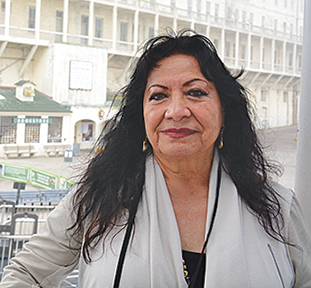War Jack featured in 'Escape to Alcatraz' documentary

Dr. LaNada War Jack
By LORI ANN EDMO
Sho-Ban News
FORT HALL — “Escape to Alcatraz” is now streaming on Hulu that tells the story of the 19 month occupation of Alcatraz Island from November 20, 1969 to June 11, 1971.
ABC 7 News San Francisco produced the documentary that features various video footage and photos from throughout the occupation – some that hasn’t been seen before.
Dr. LaNada War Jack, Shoshone-Bannock, is a last surviving leader of the Alcatraz occupation.
ABC 7 News interviewed her June 18 regarding the documentary.
War Jack was the first Native student admitted to the University of California Berkeley. While there she assisted in the establishment of an Ethic Studies department, along with a Native American Studies program.
She, along with other Native students decided to occupy Alcatraz Island to bring attention to the injustices that were happening throughout Indian Country on the reservations. She said Native people had just gone through a time period where children were taken and put into government boarding schools to assimilate them into the mainstream of American society so to upgrade that some were sent on relocation to six major cities in the country.
In the interview, War Jack was asked how the student organizers got past the Coast Guard to get on the island and she replied they didn’t see the Coast Guard anywhere, “I don’t think they were expecting us.” She was asked how it was living at Alcatraz? She said she has fears today but at the time everything was good, “I didn’t feel like it was dangerous or anything – my son enjoyed it.” They had food taken to the island, the Coast Guard tried to block them off but they just landed food and provisions on the other side of the island. They figured it out accordingly and had a lot of help from the Bay Area as well.
LaNada was asked how they knew the occupation was gaining national attention? She replied they really didn’t know the good things that were happening, they just knew they had to stay there and make sure they were noticed and have an opportunity to talk about the issues happening on rancherias, their communities and on the reservations.
After the occupation ended in June 1971 when armed federal agents stormed the island, LaNada was asked about the legacy of the occupation or impact? She said they had no idea they had left such a long term impact and legacy, they just thought they had to bring out the injustices, “We thought it was just for that time being, we didn’t know it would have a much longer impact and that we had presidential attention.”
When asked whether a national holiday should be declared for Native people parallel to Juneteenth, she said most definitely giving example of the boarding school situation in Canada finding mass graves of children the same situation happened in the United States. From Indians of All Tribes they’re asking for a forensic investigation of all the boarding schools. “We’ve had to live with that impact for generations that we call intergenerational post trauma from the boarding schools.” She said Native issues need to be taken into consideration such as Murdered, Missing, Indigenous Women, the children, along with the issues of the reservation when you couple the cycle of dysfunction poverty, alcohol and drugs it’s not a very healthy environment and we need a lot of help with that.”
As explained in the documentary, initially the students wanted the government to create a university and cultural center at Alcatraz. The government offered a theme park or a national park then later water and electricity was cutoff. However volunteers assisted with generators, along with water and food. Infiltrators alleged the occupiers had guns on the island but LaNada said she was against violence and they knew they were being set up.
In addition, many said the occupiers were a part of the American Indian Movement (AIM) but they were not – they were students.
Occupiers believe their actions brought attention to American Indian issues when President Nixon signed an executive order ending termination policy, along with an era of self-determination and increased funding for the Indian Health Service.
Much of the details of the Alcatraz occupation is detailed in Dr. War Jack’s book, “Native Resistance: An Intergenerational Fight for Survival and Life,” that can be purchased on her website drwarjack.com.





